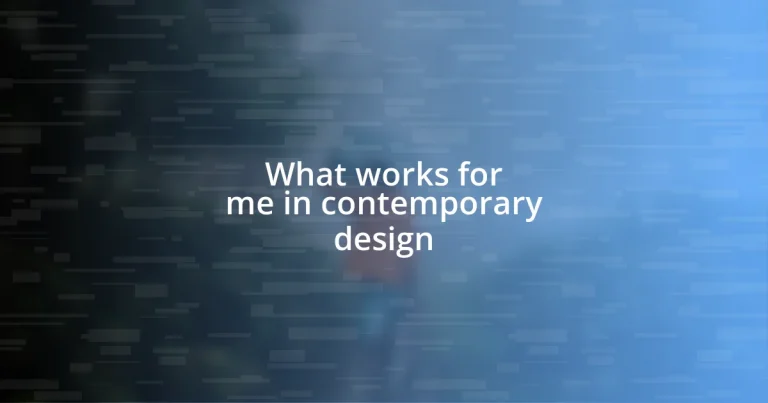Key takeaways:
- Contemporary design emphasizes innovation through clean lines, openness, and a focus on sustainability, creating spaces that enhance daily living.
- Key principles include minimalism, functionality, technology integration, and the use of diverse materials to foster aesthetic appeal and environmental responsibility.
- Personalization through meaningful items, seasonal decor, and texture layering can significantly enhance the comfort and character of a contemporary space.
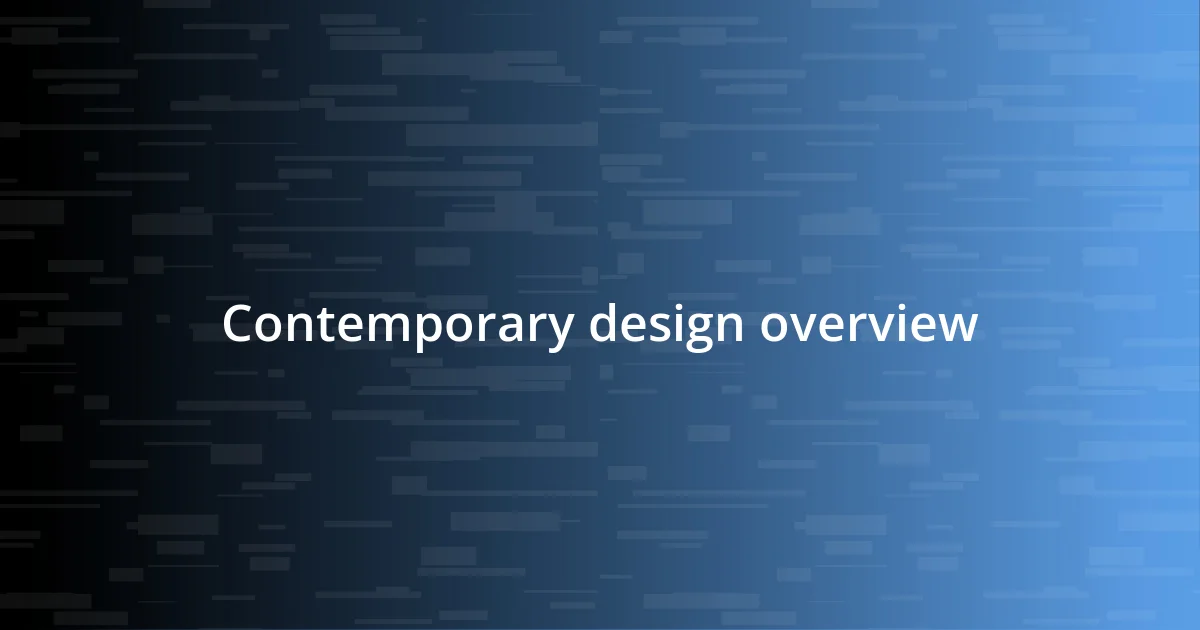
Contemporary design overview
Contemporary design is all about innovation and embracing change. I remember walking into a friend’s loft recently, where the use of mixed materials—like sleek metals and warm woods—created a space that felt both modern and comforting. Isn’t it fascinating how a simple combination can evoke such a strong emotional response?
One defining characteristic of contemporary design is its emphasis on clean lines and open spaces. When I first moved into a minimalist apartment, I was amazed by how a decluttered environment can promote clarity and focus. Have you ever noticed how a clear space can lead to clearer thoughts? It’s remarkable how these elements not only serve aesthetic purposes but also enhance our daily lives.
Sustainability plays a crucial role in contemporary design today. I recall a stunning home I visited that featured reclaimed materials and eco-friendly practices. It was incredible to see how beauty and responsibility can merge seamlessly. Isn’t it rewarding to know that the spaces we create can contribute to a healthier planet?
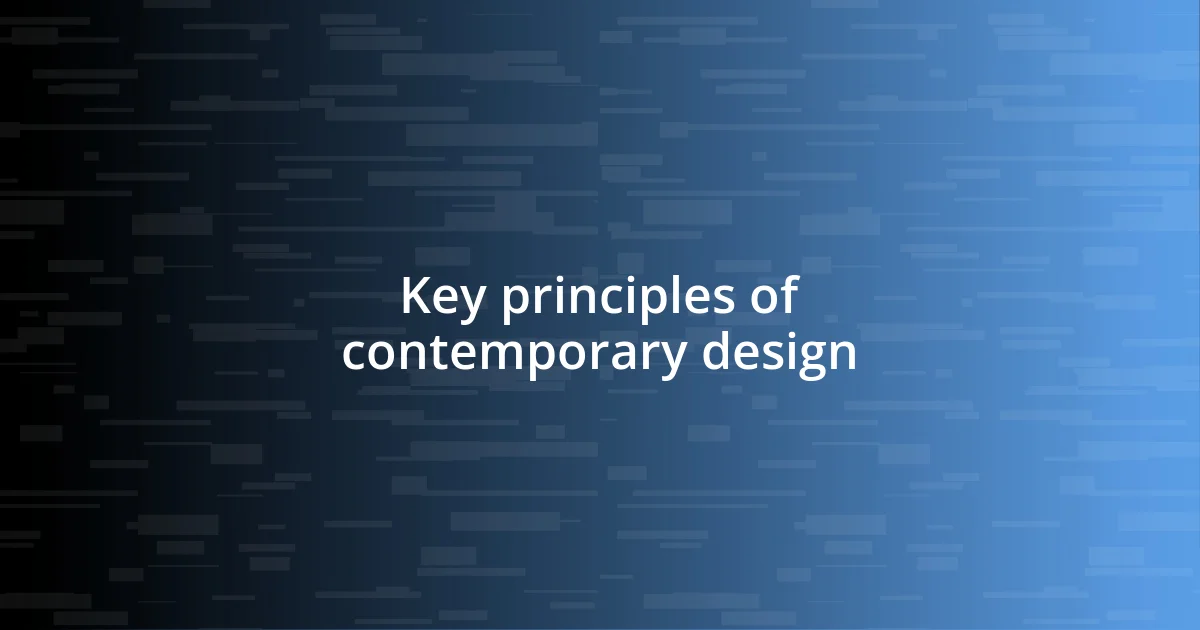
Key principles of contemporary design
Contemporary design thrives on the principles of simplicity, functionality, and sustainability. I often reflect on a recent visit to a public library that embodied these ideals beautifully. The layout was open and airy, allowing natural light to pour in, which created a serene environment perfect for reading and contemplation. It’s incredible how spatial organization can influence our mood and behavior.
Here are some key principles that I find resonate well in contemporary design:
- Minimalism: Less is more. The focus is on essential elements, with unnecessary clutter removed.
- Functionality: Every piece serves a purpose, merging aesthetics with practicality.
- Sustainability: Eco-friendly choices are prioritized, ensuring a positive impact on the environment.
- Technology Integration: Smart design incorporates modern technology seamlessly, enhancing user experience.
- Diversity of Materials: A mix of textures and finishes fosters visual interest while maintaining harmony.
Walking through spaces that prioritize these principles makes me appreciate the thoughtful approach behind each design choice. It’s like having a conversation with the space, where every element speaks of intention and care.
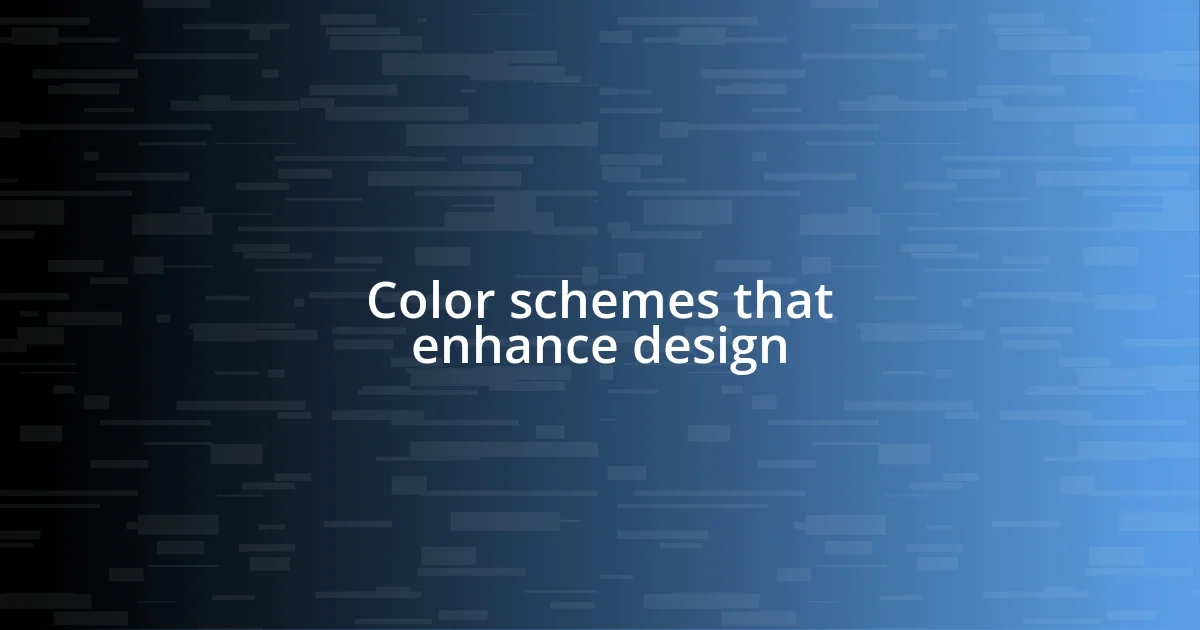
Color schemes that enhance design
Color plays a pivotal role in contemporary design, acting as a powerful tool to influence mood and perception. I’ve always found that using warm tones like deep oranges and soft yellows can create a cozy atmosphere in any space. When I painted my home office in this palette, I noticed an immediate boost in my creativity. Have you ever considered how color choices can genuinely affect how you feel in a room?
On the flip side, cool colors such as blues and greens tend to evoke calmness and tranquility. I recall attending a wellness center that used these hues extensively in its decor. The serene environment made my stress melt away. Integrating such color schemes can turn spaces into serene sanctuaries, inviting relaxation and peace into our daily lives.
Choosing a balanced palette is also essential for achieving harmony in design. I’ve experimented with complementary colors—like combining a rich burgundy with soft mint—and I was amazed at how these colors interacted, creating visual interest without overwhelming the senses. Below is a table summarizing some effective color schemes and their emotional impacts:
| Color Scheme | Emotional Impact |
|---|---|
| Warm Tones (e.g., reds, oranges, yellows) | Inviting, Energizing |
| Cool Tones (e.g., blues, greens) | Calming, Peaceful |
| Neutral Palettes (e.g., beiges, grays) | Balanced, Timeless |
| Contrasting Colors (e.g., blue and orange) | Dynamic, Engaging |
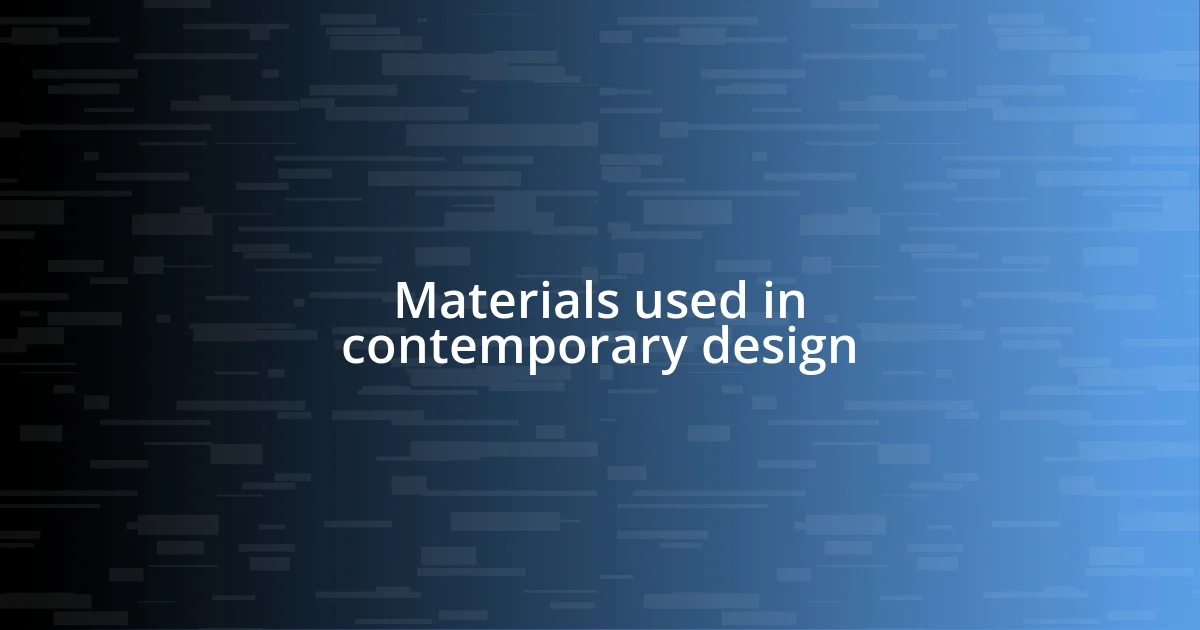
Materials used in contemporary design
Contemporary design embraces a diverse range of materials, each contributing to the unique character of a space. I’ve always been captivated by how unexpected combinations can create such striking results. For instance, mixing wood with concrete brings warmth to the often-cold industrial feel of urban spaces. Have you ever walked into a room that left you in awe because of the material choices? It’s like a sensory journey—different textures tell their own stories.
Sustainable materials are particularly close to my heart. I remember the first time I encountered bamboo flooring; its natural beauty and eco-friendliness immediately resonated with me. It’s incredible to think that such choices not only enhance aesthetic appeal but also promote environmental responsibility. Incorporating recycled materials into contemporary design fosters a sense of innovation, as well. The thought of repurposing items that might otherwise be discarded speaks to my appreciation for creativity in problem-solving.
Lastly, I’m increasingly drawn to the use of textiles in contemporary environments. Fabrics can dramatically transform a space; I experienced this firsthand when I added a few bold, patterned throw pillows to my minimalist sofa. The change was instant—the room felt more inviting, spilling over with personality. Isn’t it fascinating how something as simple as a choice of fabric can shift the entire vibe of a space?
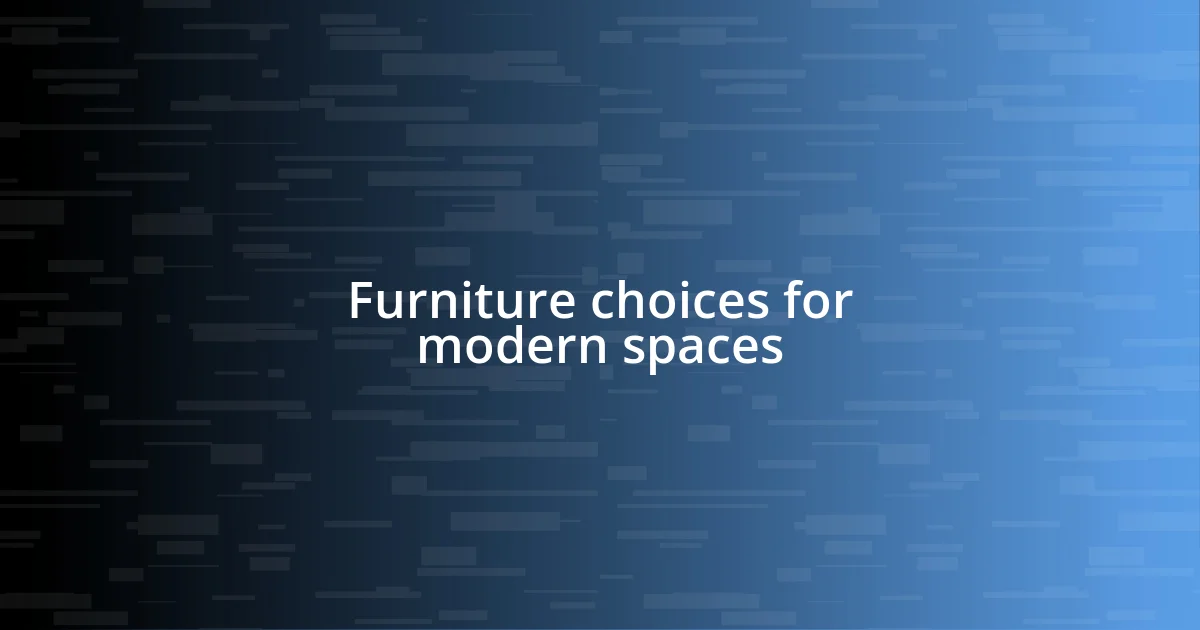
Furniture choices for modern spaces
When it comes to furniture choices for modern spaces, I always prioritize multifunctional pieces. For example, my sleek coffee table doubles as a storage unit, which has become a game-changer in my living room. Have you ever felt overwhelmed by clutter? This clever design solution not only minimizes chaos but also maintains a clean, contemporary aesthetic that I truly appreciate.
I also find that prioritizing comfort doesn’t mean sacrificing style. Recently, I invested in an ergonomic lounge chair that boasts a chic silhouette without compromising on coziness. Each time I sink into it, it feels like a warm embrace—perfect for those long reading sessions. Isn’t it satisfying when your furniture invites you to relax and enjoy your space?
Lastly, I’m a huge fan of statement pieces that inspire conversation. I once spotted a strikingly designed geometric bookshelf that caught my eye at a local artisan market. It instantly became the focal point of my home office, sparking endless discussions with visitors. Don’t you think that a well-chosen piece can transform an ordinary room into a gallery of personal expression?

Lighting techniques for effect
Lighting can truly make or break a space, and I’ve seen firsthand how effective techniques can create entirely different moods. For example, when I moved into my last apartment, I replaced standard overhead lights with warm LED strips that I tucked into shelf edges. The difference was astounding—what had felt like a stark, sterile environment transformed into a cozy, inviting retreat in the evenings. Have you ever experienced that shift in atmosphere just by adjusting the lighting?
Layering light is another technique I’m particularly passionate about. In my studio, I use ambient, task, and accent lighting strategically. The ambient lighting fills the room with general illumination, while spotlights highlight artwork on the walls. I remember hosting a small gathering where I dimmed the overheads while showcasing my favorite pieces. The guests were drawn in, admiring the glowing artwork, and the entire vibe shifted to one of intimacy and creativity. It’s remarkable how thoughtful lighting can guide emotions and facilitate connections.
Finally, I’ve also enjoyed experimenting with colored lighting to add an extra layer of expression. One night, out of pure curiosity, I installed smart bulbs that allowed me to change colors with my phone. I set the mood to a soft blue while enjoying a quiet evening with a book; it felt like I was wrapped in a serene blanket. This technique can shift the energy of a room at a moment’s notice. Have you ever thought about how the color of light can influence not just the look of a space but also your feelings within it? It certainly made me appreciate the power of lighting even more.
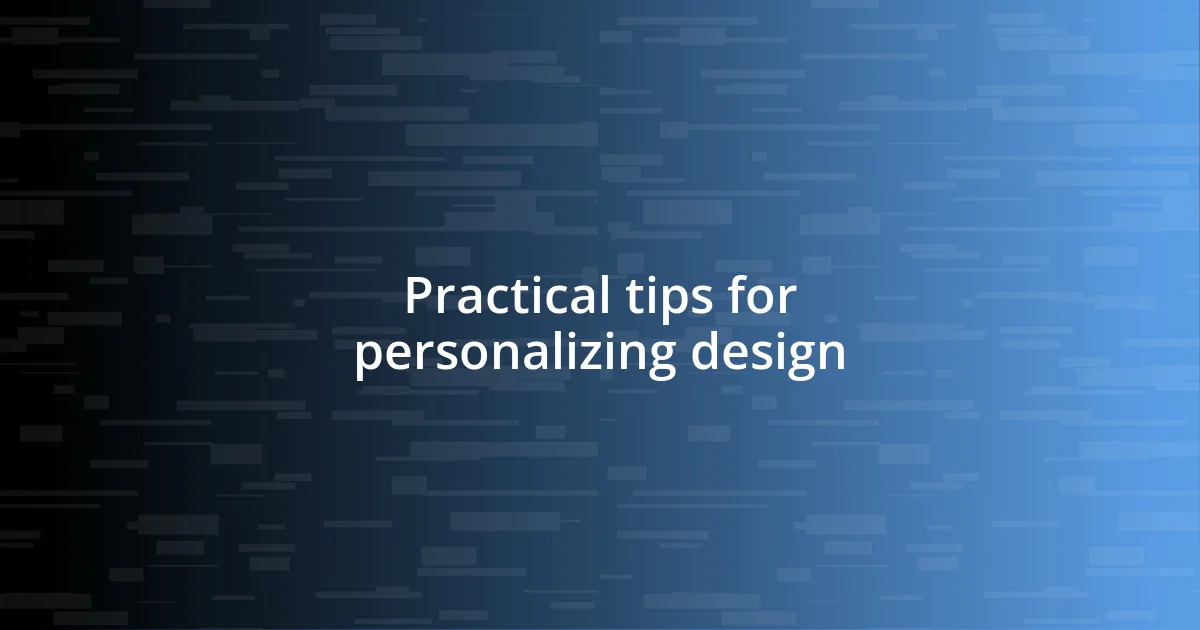
Practical tips for personalizing design
To truly personalize your design, I recommend incorporating items that have personal significance. For instance, I have a collection of vintage globes passed down from my grandfather. Each globe carries a story, and displaying them on a shelf not only sparks nostalgia but also adds unique character to my space. Have you ever considered how meaningful items can breathe life into a room?
Another approach I love is to infuse seasonal decor into my space. I rotate my accent pillows and artwork depending on the season, which keeps my environment fresh and inviting. Recently, I swapped my muted fall tones for bright, cheerful colors as spring approached, and the transformation was delightful. It reminded me that design doesn’t have to be static; it can evolve with our lives and the changing seasons.
In addition, I find that playing with textures can have a profound impact. I once layered a knitted throw over a sleek leather sofa, resulting in a cozy contrast that feels both inviting and stylish. Every time I curl up on that couch with a warm beverage, the combination of textures welcomes me. Have you thought about how tactile elements can enhance your experience in a space? It’s amazing what a small change can do.












